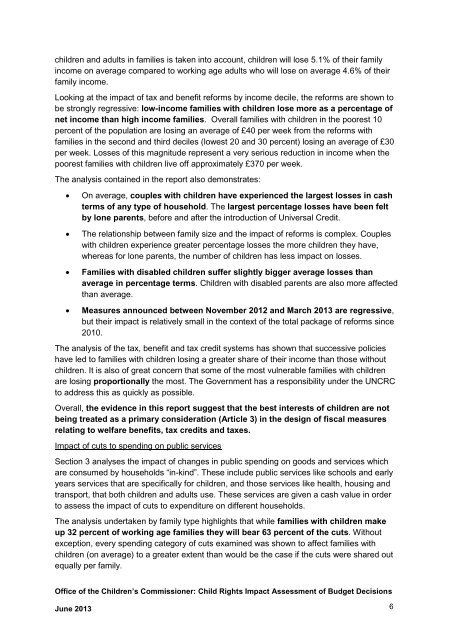force_download.php?fp=/client_assets/cp/publication/676/A_Child_Rights_Impact_Assessment_of_Budget_Decisions
force_download.php?fp=/client_assets/cp/publication/676/A_Child_Rights_Impact_Assessment_of_Budget_Decisions
force_download.php?fp=/client_assets/cp/publication/676/A_Child_Rights_Impact_Assessment_of_Budget_Decisions
You also want an ePaper? Increase the reach of your titles
YUMPU automatically turns print PDFs into web optimized ePapers that Google loves.
children and adults in families is taken into account, children will lose 5.1% <strong>of</strong> their family<br />
income on average compared to working age adults who will lose on average 4.6% <strong>of</strong> their<br />
family income.<br />
Looking at the impact <strong>of</strong> tax and benefit reforms by income decile, the reforms are shown to<br />
be strongly regressive: low-income families with children lose more as a percentage <strong>of</strong><br />
net income than high income families. Overall families with children in the poorest 10<br />
percent <strong>of</strong> the population are losing an average <strong>of</strong> £40 per week from the reforms with<br />
families in the second and third deciles (lowest 20 and 30 percent) losing an average <strong>of</strong> £30<br />
per week. Losses <strong>of</strong> this magnitude represent a very serious reduction in income when the<br />
poorest families with children live <strong>of</strong>f approximately £370 per week.<br />
The analysis contained in the report also demonstrates:<br />
<br />
<br />
<br />
On average, couples with children have experienced the largest losses in cash<br />
terms <strong>of</strong> any type <strong>of</strong> household. The largest percentage losses have been felt<br />
by lone parents, before and after the introduction <strong>of</strong> Universal Credit.<br />
The relationship between family size and the impact <strong>of</strong> reforms is complex. Couples<br />
with children experience greater percentage losses the more children they have,<br />
whereas for lone parents, the number <strong>of</strong> children has less impact on losses.<br />
Families with disabled children suffer slightly bigger average losses than<br />
average in percentage terms. <strong>Child</strong>ren with disabled parents are also more affected<br />
than average.<br />
<br />
Measures announced between November 2012 and March 2013 are regressive,<br />
but their impact is relatively small in the context <strong>of</strong> the total package <strong>of</strong> reforms since<br />
2010.<br />
The analysis <strong>of</strong> the tax, benefit and tax credit systems has shown that successive policies<br />
have led to families with children losing a greater share <strong>of</strong> their income than those without<br />
children. It is also <strong>of</strong> great concern that some <strong>of</strong> the most vulnerable families with children<br />
are losing proportionally the most. The Government has a responsibility under the UNCRC<br />
to address this as quickly as possible.<br />
Overall, the evidence in this report suggest that the best interests <strong>of</strong> children are not<br />
being treated as a primary consideration (Article 3) in the design <strong>of</strong> fiscal measures<br />
relating to welfare benefits, tax credits and taxes.<br />
<strong>Impact</strong> <strong>of</strong> cuts to spending on public services<br />
Section 3 analyses the impact <strong>of</strong> changes in public spending on goods and services which<br />
are consumed by households “in-kind”. These include public services like schools and early<br />
years services that are specifically for children, and those services like health, housing and<br />
transport, that both children and adults use. These services are given a cash value in order<br />
to assess the impact <strong>of</strong> cuts to expenditure on different households.<br />
The analysis undertaken by family type highlights that while families with children make<br />
up 32 percent <strong>of</strong> working age families they will bear 63 percent <strong>of</strong> the cuts. Without<br />
exception, every spending category <strong>of</strong> cuts examined was shown to affect families with<br />
children (on average) to a greater extent than would be the case if the cuts were shared out<br />
equally per family.<br />
Office <strong>of</strong> the <strong>Child</strong>ren’s Commissioner: <strong>Child</strong> <strong>Rights</strong> <strong>Impact</strong> <strong>Assessment</strong> <strong>of</strong> <strong>Budget</strong> <strong>Decisions</strong><br />
June 2013 6



